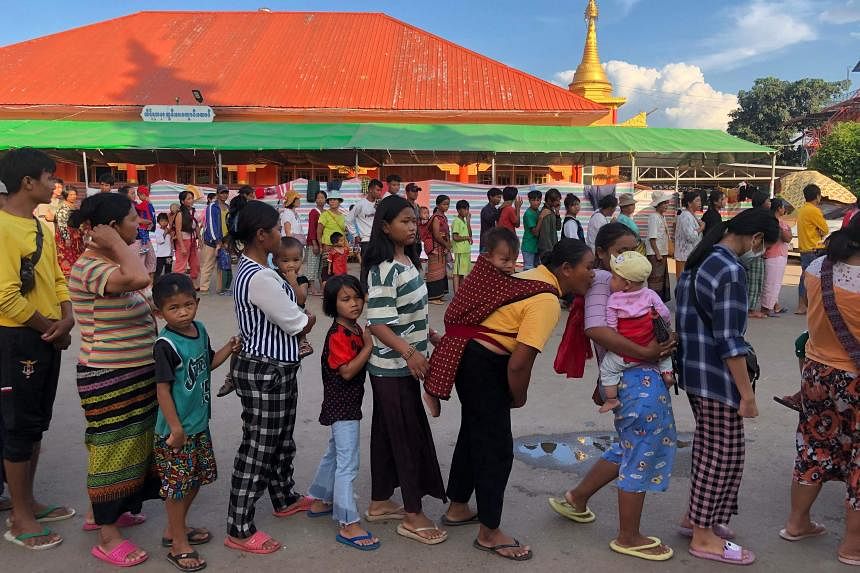CHIANG MAI - In the border regions of Myanmar, where civilians dodge air raids and artillery fire daily, many students have found new ways to continue their education.
“School” is often a tarpaulin shelter in the jungle, with “classrooms” dispersed over a wide area to avoid the attention of the Myanmar junta, which is fighting groups resisting its rule.
Textbooks are printed in Thailand and transported in small batches over the Thai-Myanmar border, but there are never enough.
Other times, “school” is a black box around which over a dozen students congregate. Using their mobile phones or laptops, they hop onto the local area network emitted by this battery-powered computer.
They join self-paced courses and upload assignments that can be graded later by tutors anywhere in the world.
The device, called the EduLamp, is the brainchild of Spring University Myanmar (SUM), a project driven by local and international volunteers, experts, development agencies and institutes to provide education amid Myanmar’s turmoil.
There are currently 21 of these devices operating in Karen, Kayah and Chin states, as well as the Bago and Sagaing regions – areas where some of the fiercest fighting between the Myanmar military and resistance forces have taken place since the February 2021 coup.
It is one of the alternative education models that have sprung up since the coup, which triggered a mass civil disobedience movement involving students, teachers, doctors and other segments of society, as well as broader rethink of curricula.

In major cities such as Yangon and Mandalay, some families still boycotting schools controlled by the junta have enrolled their children in the more than 70 online schools recognised by Myanmar’s parallel National Unity Government.
But the blackouts, Internet disruptions and the deteriorating economy have made more families think twice about keeping their children out of regime-run schools, especially with the crisis grinding towards its third year.
According to state media, over 5.8 million students were enrolled in state basic education schools, private schools and monastic education schools for the academic year spanning 2023 and 2024.
This was up from 5.6 million the previous year. Before the coup, in the 2019-2020 academic year, Myanmar had roughly nine million students.
SUM, which offers courses and diplomas in social sciences, economics, public policy, law and human rights online, has taught over 17,000 students since starting in 2021.
It helped boost the confidence of students such as 23-year-old Fred, who asked for the use of pseudonym for security reasons.
Already armed with a bachelor’s degree in English literature, he enrolled in SUM’s diploma course in human rights and democratic governance in 2022. This eventually helped him win a full graduate scholarship to study human rights and the arts at a university in New York state, he told The Straits Times.
“I faced challenges with unstable Internet and electricity during my studies, which occasionally made it difficult to learn with comfort. However, the instructors and teaching assistants are very understanding as long as we communicate clearly with them,” he said.
SUM enrolment figures, however, are dropping, according to a staff member who asked to be identified as Eric for his safety.
“After over two years, some students have gone back to (State Administration Council) institutes, some have gone abroad to study, and some have gone into the workplace, because the revolution is taking too long,” he told ST in an interview in Chiang Mai.
He was referring to the effort to overthrow the junta, which calls itself the State Administration Council.
Given the junta’s tightening surveillance of online traffic, students from modest backgrounds who refuse to submit to the military regime often have to choose between waiting out this prolonged political crisis or being educated under the junta.
Parents interviewed by the Straits Times were anxious about falling education standards and tried to send their children for tuition classes if they could afford it.
Education options are more meagre in war-torn areas, where clashes between the military and armed resistance groups keep civilians on the run.
The EduLamp, according to Eric, could meet some of these gaping education needs. It acts like a service provider, delivering lessons that can be tailored to local needs through a cheap computer called Raspberry Pi. The device, which costs US$500 (S$670) to US$800 to produce, can run for six hours on a portable power bank.
By the end of 2024, there will be 57 EduLamps in the country, he said.
War is currently being waged in 67 per cent of Myanmar’s townships, according to the Institute for Strategy and Policy Myanmar. This has displaced over four million people, or more than seven per cent of the population.
The most intense clashes are now taking place in the northern regions, where allied ethnic armed groups Arakan Army, Myanmar National Democratic Alliance Army and the Ta’ang National Liberation Army have overrun many junta-allied forces.
In Karen state, the control of schools has followed contours of the armed conflict.
The number of schools under the care of the Karen National Union (KNU), another ethnic armed organisation, swelled from 382 to over 900 over the past three years as it progressively took over junta territory, reported the civil society Karen Peace Support Network in September.
Part of this expansion was driven by the large numbers of teachers who switched from the state system to working under the KNU system after the coup.
But the growth in schools has not meant an expansion of KNU’s education system.
This is because there are not enough textbooks and teachers familiar with the Karen-language focused curriculum, said Mr Ko Lo Htoo, deputy director of the Karen Teacher Working Group (KTWG) which coordinates the teaching.
As a result, many KNU-controlled schools have continued to use the mainstream Burmese-language curriculum rather than the one that is more sensitive to Karen culture and history.
The KTWG is revamping the curriculum through a process that will take three to four years, he added. A similar effort is taking place in neighbouring Kayah State, where ethnic Karennis have strongly resisted junta rule.
Meanwhile, Karen educators are finding ways to keep their 120,000 students safe. At least 18 schools have been destroyed by air strikes or artillery attacks since the coup, Mr Kho Lo Htoo, said.
“We are thinking about removing schools from villages and rebuilding them outside. But it would be challenging for the students to travel there and back – at least half an hour each way. Along the way, they would need to cross the river and jungle, which would bring its own risks.”


